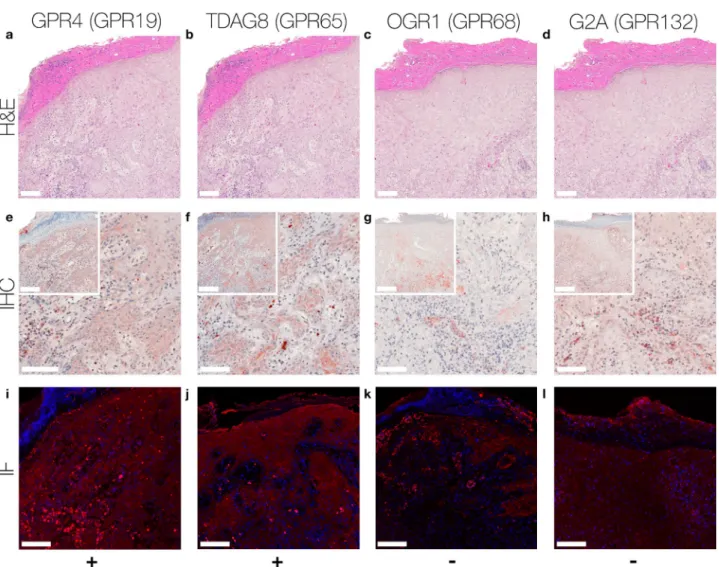www.nature.com/scientificreports
Expression profiles
of proton‑sensing G‑protein
coupled receptors in common skin tumors
Wybke Klatt
1, Susanne Wallner
1, Christoph Brochhausen
2, Judith A. Stolwijk
1,3,4&
Stephan Schreml
1,4*The proton-sensing GPCRs (pH-GPCRs) GPR4 (GPR19), TDAG8 (GPR65, T-cell death associated gene 8), OGR1 (GPR68, ovarian cancer GPCR1), and G2A (GPR132, G2 accumulation protein) are involved in sensing and transducing changes in extracellular pH (pH
e). Extracellular acidification is a central hallmark of solid cancer. pH-GPCR function has been associated with cancer cell proliferation,
adhesion, migration and metastasis, as well as with modulation of the immune system. Little is known about the expression levels and role of pH-GPCRs in skin cancer. To better understand the functions of pH-GPCRs in skin cancer in vivo, we examined the expression-profiles of GPR4, TDAG8, OGR1 and G2A in four common skin tumors, i.e. squamous cell carcinoma (SCC), malignant melanoma (MM), compound nevus cell nevi (NCN), basal cell carcinoma (BCC). We performed immunohistochemistry and immunofluorescence staining on paraffin-embedded tissue samples acquired from patients suffering from SCC, MM, NCN or BCC. We show the expression of pH-GPCRs in four common skin cancers. Different expression patterns in the investigated skin cancer types indicate that the different pH-GPCRs may have distinct functions in tumor progression and serve as novel therapeutic targets.
In 2019, the United States are projecting 1,762,450 new cancer cases to occur
1. Over the past decade particu- larly skin cancer, one of the most common types of malignancies, has shown an increasing incidence
2,3. Among non-melanoma skin cancers, squamous cell carcinoma (SCC) grows slow over months and only 4% of the SCC tumours metastasise, leading to significant patient morbidity
4. SCC is the second most-frequent cutaneous malignancy, preceded in frequency by the basal cell carcinoma (BCC). BCC is characterised by a slow growing behaviour and metastases are extremely rare
5. Nevus cell nevi (NCN) are benign melanocytic lesions which do not require any intervention
6. The malignant melanoma (MM) develops from the nevus cell nevus in one third of the cases
7. Although MM represents only 2% of the malignant skin cancer incidents, it is still one of the deadliest skin cancers with a rapid systematic dissemination
8,9.
G-protein coupled receptors (GPCRs) are one of the most diverse classes of cell surface receptors with over 500 representatives in eukaryotes, including animals, plants, fungi and the human body, where they fulfil a multitude of crucial individual tasks
10,11.
The pH-sensitive GPCRs (pH-GPCRs) GPR4 (GPR19), TDAG8 (GPR65, T-cell death associated gene 8), OGR1 (GPR68, ovarian cancer GPCR1) and G2A (GPR132, G2 accumulation protein) are activated by protons in the extracellular environment, presumably through binding to specific histidine residues at the extracellular surface of these receptors
12. Under healthy conditions the central function of these proton sensors seems the maintenance of homeostasis. However, in tumours it is believed that certain pH-GPCRs may help to establish a growth advantage while others inhibit growth
13,14. Moreover, there are differences between the tumor types
15.
Tumor pH often differs from normal tissue. While standard stromal cells maintain intracellular pH (pH
i) in a narrow range of 6.9–7.2 compared to the extracellular pH (pH
e) of 7.2–7.4, tumors exhibit lower pH
e(6.2–7.0)
open
1

